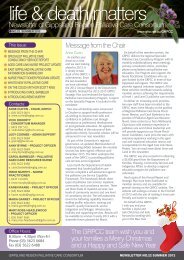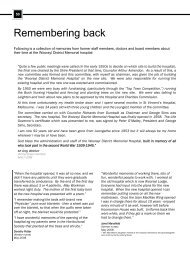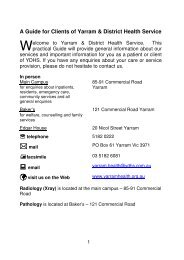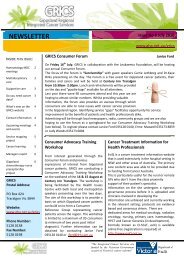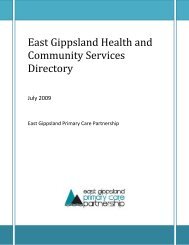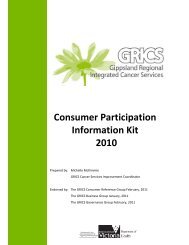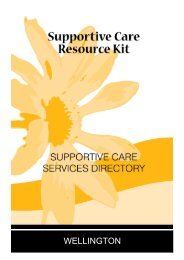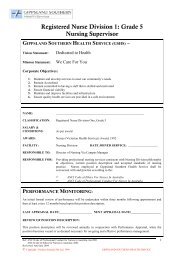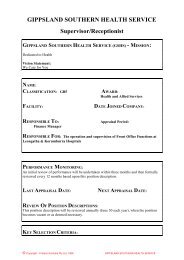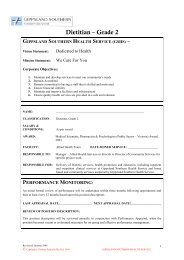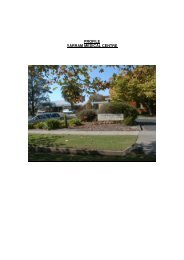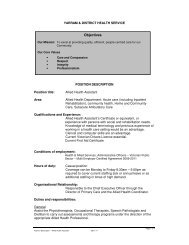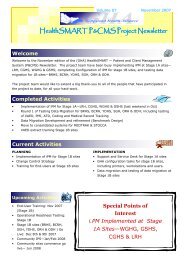Building for a brighter future - GHA Central
Building for a brighter future - GHA Central
Building for a brighter future - GHA Central
You also want an ePaper? Increase the reach of your titles
YUMPU automatically turns print PDFs into web optimized ePapers that Google loves.
Review of Operations: Quality Report<br />
West Gippsland Healthcare Group strongly supports a learning<br />
environment that reviews systems and processes in the light of<br />
errors, so that we can improve the care we provide to our<br />
community.<br />
Safe Quality Care<br />
Healthcare organisations are large<br />
complex places managing many<br />
integrated processes and systems.<br />
Research into what makes healthcare<br />
organisations safer places is clear.<br />
More often than not, mistakes happen<br />
as a result of a sequence of events that<br />
go astray. At WGHG, if a mistake<br />
occurs, our learning culture allows<br />
us to understand how we can prevent<br />
similar mistakes from happening again.<br />
To do this, we are building on our<br />
safety culture; a culture where staff<br />
feel com<strong>for</strong>table to report things that<br />
go wrong without feeling they will<br />
be blamed, punished or ignored.<br />
This culture supports an active<br />
investigation learning environment.<br />
What WGHG does to improve safety<br />
➤ We encourage staff to report<br />
incidents and close calls (near<br />
misses). As a result, this year the<br />
number of incident reports has<br />
increased by 41% from an average<br />
of 92 per month to an average of<br />
130 per month, providing more<br />
opportunities to learn<br />
➤ We review and investigate all<br />
incidents and near misses in a “no<br />
blame, no shame” way to identify<br />
contributing factors<br />
➤ We use a comprehensive<br />
investigation process that aims to<br />
understand what happened and<br />
why it happened, on all major or<br />
serious incidents<br />
➤ We involve all departments in safety<br />
and quality improvement activities<br />
➤ We involve experienced medical<br />
and nursing staff in reviewing<br />
patient records to confirm<br />
appropriate care was given<br />
and documented<br />
➤ We have committees and working<br />
parties linking medical, nursing,<br />
allied health and support services<br />
to monitor, review and recommend<br />
quality and safety improvements<br />
➤ These committees and working<br />
parties report to the Clinical Quality<br />
Committee who, in turn, reports to<br />
the Board’s Standards Committee<br />
to ensure that there is a high level<br />
of responsibility <strong>for</strong> safe quality care<br />
(Clinical Governance)<br />
➤ We measure our safety and quality<br />
per<strong>for</strong>mance and compare it to the<br />
per<strong>for</strong>mance of other organisations<br />
wherever possible<br />
➤ We learn from incidents that occur<br />
in other organisations<br />
➤ We listen, investigate and learn<br />
from complaints<br />
➤ At WGHG, larger programs or<br />
projects target key patient safety<br />
risks such as infection control,<br />
falls and pressure areas<br />
➤ We develop and regularly review<br />
policies, procedures and guidelines<br />
to ensure they reflect current best<br />
practice<br />
➤ We provide ongoing education<br />
and support to ensure our staff<br />
are skilled and up to date<br />
➤ Our equipment is regularly tested,<br />
maintained and replaced to ensure<br />
it meets our clinical needs<br />
(continued on page 22)<br />
Incident reporting<br />
Incident reporting is a key component<br />
of the clinical risk management<br />
program.<br />
In March 2006, WGHG introduced<br />
a severity rating system <strong>for</strong> all<br />
incidents. Incidents are rated<br />
according to severity from 1 to 4,<br />
most severe incidents being rated<br />
1 and least severe rated 4. Most<br />
incidents occurring at WGHG have<br />
a low severity rating (3 or 4). A weekly<br />
100<br />
80<br />
60<br />
40<br />
20<br />
0<br />
Types of Incidents Reported at WGHG<br />
624<br />
Falls<br />
Medication/IV related 244<br />
OH&S - Physical injury 237<br />
Miscellaneous 227<br />
107<br />
Aggression related<br />
incidents<br />
29<br />
Equipment or<br />
instrument related<br />
26<br />
OH&S - Exposure<br />
contaminated related<br />
Clinical Risk and Evaluation (CARE)<br />
meeting enables the Executive team to<br />
look at all incident reports. Incidents<br />
with a higher severity rating (1 or 2)<br />
are investigated and reviewed. The<br />
risks identified are directed to the<br />
appropriate area to be addressed<br />
and strategies are implemented to<br />
minimise the chances of a similar<br />
incident occurring. Incidents rated<br />
3 and 4 are recorded and monitored<br />
to look <strong>for</strong> trends that may indicate<br />
a problem is emerging.<br />
Property 22<br />
Absconding 15<br />
OH&S - Others 11<br />
8<br />
Related to consent and<br />
patient identification<br />
Communications disputes 7<br />
Diagnostic incidents 7<br />
Administrative/<br />
contractual 5<br />
In response to incidents we have:<br />
➤ Implemented a critical instability call<br />
process, improving the process <strong>for</strong><br />
nursing staff to call <strong>for</strong> specialist<br />
medical support quickly<br />
➤ Developed and implemented fluid<br />
balance chart and medication<br />
handover policy on all wards. This<br />
provides an opportunity <strong>for</strong> staff<br />
to double check <strong>for</strong> early changes<br />
in patients fluid balance or where<br />
medications may have been missed<br />
➤ Standardised the times that<br />
Warfarin (blood thinning<br />
medication) is given, reducing<br />
the likelihood of it not being given<br />
and blood tests being missed<br />
➤ Improved processes <strong>for</strong> staff and<br />
in<strong>for</strong>mation <strong>for</strong> families when the<br />
death of a loved one is reported<br />
to the Coroner<br />
➤ Reviewed incident reporting systems,<br />
educated and encouraged staff to<br />
report incidents<br />
➤ Reviewed Emergency department<br />
pathology collection times ensuring<br />
pathology requests are delivered at<br />
appropriate times be<strong>for</strong>e pathology<br />
staff leave in the evening.<br />
21



